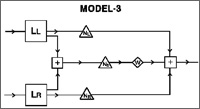J. Vernon Odom, PhD
Contact Information
- Phone
- 304-598-6959
- Address
-
PO Box 9193
WVU Eye Institute
Morgantown, WV 26506
Research Interests
Low Vision and Orientation, Mobility, and Action

One of the major issues in low vision is the ability of patients with low vision to maintain their independence and to avoid accidents. Stated in another way we may ask: how does reducing visual input alter people's ability to navigate and perform visually guided motor tasks, such as pouring a cup of coffee or other activities of daily living? Does the type of impairment, loss of central field, loss of peripheral field, or patchy loss have distinctive effects? What roles do changes in sensitivity to specific visual cues and knowledge (familiarity) with their environment play in people's ability to be mobile and active?
Understanding the relationship between low vision, sensitivity to optic flow, and mobility also has important implications for low vision rehabilitation. Are the compensatory strategies that have been developed for rehabilitating low vision patients optimal? Frequently low vision rehabilitation involves prescribing optical devices. Do optical devices compensate for or exacerbate a way of overcoming difficulties?
Optic Flow and Mobility
One of the major clues for determining one's visual direction or heading is optic flow, i.e., the relative change in positions of objects at different places in the visual field as one moves. In an optic flow field there is a point from which all of the changes flow. As one moves forward, this point does not change. This stationary point of expansion (POE) is the point toward which the person is heading. To the best of our knowledge there are no studies that determine the sensitivity of low vision patients to optic flow information or compare their sensitivity to that of age-matched controls. These simple demonstrations will be the initial step in our research program. They will be followed by studies, which determine the relationship between an individual patient's ability to detect optic flow information and their ability to perform simple mobility tasks.


Understanding Binocular Vision
Understanding binocular vision and the influence of parallel visual processing is a continuing research interest. We have developed a model of binocular luminance interaction based on evoked potential and psychophysical studies in humans and nonhuman primates (see figure). Currently we are exploring possible ways to determine the relevance of the model to abnormal binocular vision as seen in patients with amblyopia or low vision.

Grants and Research
Research Support (Selected from 34 grants and contracts)
Active: None
National Eye Institute Support
$130,000. PI: J. Vernon Odom, Ph.D. September 1981- August 1985. Normal and Abnormal Development of Binocularity, R01 EY03781, EY04806
$300,000 PI: J. Vernon Odom, Ph.D. September 2003- August 2008. Higher Order Visual Perception: Effects of Low Vision in Elderly Patients. RO3 EY 14841
$440,367 PI: Janine Mendola., Ph.D. March 2006 – February 2008 Functional Brain Imaging of Human Amblyopia. RO1 EY015219, Role: Co-Investigator,
Publications
Publications in Peer Reviewed Journals (selected from 85)
- Ortiz G, Odom JV, Passaglia CL, Tzekov RT (2017). Efferent influences on the bioelectrical activity of the retina in primates. Doc Ophthalmol, 134(1):57-73.
- Odom JV, Bach M, Brigell M, Holder GE, McCulloch DL, Mizota A, Tormene AP, International Society for Clinical Electrophysiology of Vision (2016). ISCEV standard for clinical visual evoked potentials: (2016 update). Doc Ophthalmol, 133(1):1-9.
- Teoli DA, Smith MD, Leys MJ, Jain P, Odom JV (2016). Visual function affects prosocial behaviors in older adults. Int Ophthalmol, 36(1):45-54.
- Halfeld Furtado de Mendonça, R, Abbruzzese S, Bagolini B, Italo Nofroni I, Ferreira EL, Odom JV (2013). Visual evoked potential importance in the complex mechanism of amblyopia. Int Ophthalmol, 33(5):515-9. PMCID: PMC3782652
- Takaaki K, Tillman WT, Schwartz TL, Linberg JV, Odom JV (2013). Health-related quality of life after surgical removal of an eye.Ophthal Plast Reconstrr Surg, 29(1), 51-6. PMCID: PMC3541504
- Wiley L, McAllister M, Wiley LA, Elliott T, Bridge D, Odom JV, Olson J (2012).Bacterial biofilm diversity in contact lens-related disease: emerging role ofAchromobacter , Stenotrophomonas , and Delftia . I nvest Ophthalmol Vis Sci, 53(7):3896-3905; doi:10.1167/iovs.11-8762
- Wu F, Yang Y, Li H,. Odom JV (2011). Relationship of chromatic visual-evoked potentials and the changes of foveal photoreceptor layer in central serous chorioretinopathy patients. Ophthalmic Physiol Opt, 31(4), 381-388
Recent: Book Chapters, Proceedings and Editorials (selected from 47)
- Brodie, S., Odom, J.V., and Leys, M.J.J. Clinical Visual Electrophysiology. In W. Tasman and E.A. Jaeger (eds.). Duane's Clinical Ophthalmology. Vol. 3. Chapter 5, Philadelphia, PA: J.B. Lippincott Co., 2011.
- Odom, J. V. and Green M. Visual Aging and Driving. Marc Green, Merrill J. Allen, Bernard S. Abrams, Leslie Weintraub and J. Vernon Odom. Forensic Vision: With Application to Highway Safety. 3rd ed. Tucson, Az: Lawyers & Judges Publishing, 2008.
- Odom, J.V. Amplifiers and special purpose data acquisition systems. In Heckenlively J, Arden G, eds. Handbook of Clinical Electrophysiology of Vision Testing, 2nd Ed. The MIT Press: Cambridge, MA (2006).
- Odom, J.V. Kernel analysis.In Heckenlively J, Arden G, eds. Handbook of Clinical Electrophysiology of Vision Testing, 2nd Ed. The MIT Press: Cambridge, MA (2006).
- Walter, C., Humble, H, Althouse ,R, Odom, J.V. A comparison of low-vision patients from a clinic and a random sample of West Virginians: demographics, treatment patterns, vision problems, and activities of daily living. In Jones S, Rubin G, Hamlin D, eds. Vision 2005— Proceedings of the International Congress held between 4–7 A pril 2005 in London, UK, International Congress Series (2006), 1282:462-465.